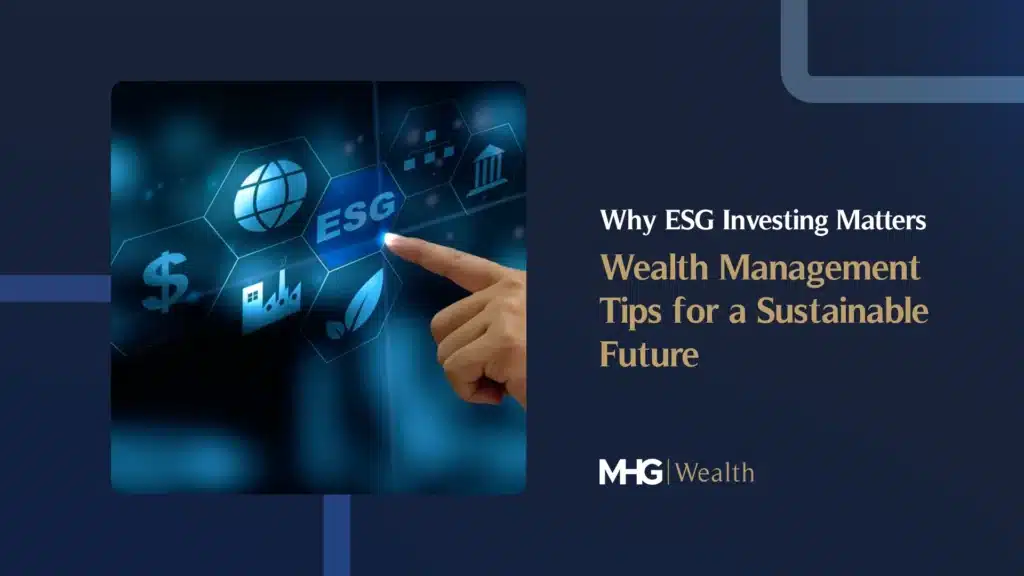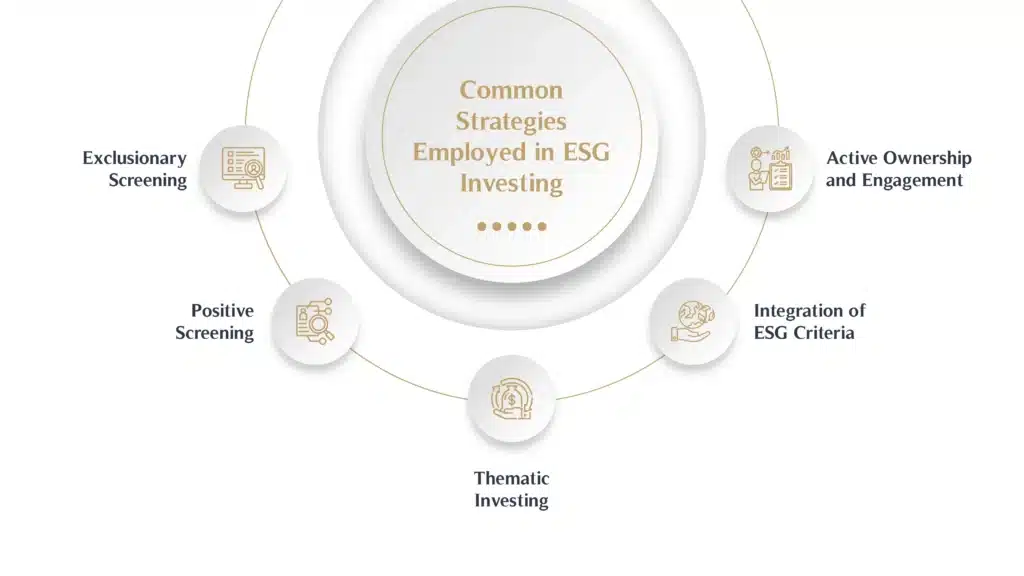In today’s dynamic financial world, investment decisions extend far beyond profit margins – it’s about impact. ESG (Environmental, Social, and Governance) investing has emerged as a game-changer that offers a pathway for individuals and businesses to grow wealth responsibly while contributing to a sustainable future.
At MHG Wealth, we understand that building wealth isn’t just about numbers; it’s about creating a meaningful legacy.
Whether you’re new to sustainable investing or seeking to optimise your portfolio, understanding the principles of ESG investing can help you achieve both financial success and a lasting positive impact.
In this guide, we will explain why ESG investing matters and how it can be an essential part of your wealth management strategy.
What is ESG Investing?
ESG investing is a framework that evaluates investments through the lens of Environmental, Social, and Governance (ESG) criteria. This approach not only focuses on financial returns but also considers the broader impact of investments on society and the planet. It’s a way to align financial goals with values, helping investors contribute to a more sustainable and equitable future.
Unlike traditional investments focused solely on profit, ESG investing involves evaluating investments based on three critical factors:
Environmental:
This criteria assesses how a company interacts with the natural world. Key areas include:
- Carbon emissions and climate impact.
- Waste management and resource efficiency.
- Commitment to renewable energy and sustainability practices.
Social:
This focuses on how a company manages relationships with employees, communities, and customers. Key metrics include:
- Workplace diversity, equity, and inclusion.
- Employee rights, well-being, and safety measures.
- Community engagement and philanthropic initiatives.
Governance:
Governance examines the internal systems and practices that drive ethical and transparent decision-making. Key areas include:
- Transparency in decision-making and reporting.
- Fair executive compensation and shareholder rights.
- Adherence to ethical business practices and anti-corruption policies.
Together, these criteria provide a holistic view of a company’s long-term sustainability and ethical stance, enabling investors to make informed decisions.
Historical Context and Evolution of ESG Investing
The roots of ESG investing can be traced back to the 1960s, with the rise of socially responsible investing (SRI). Initially, investors focused on excluding industries such as tobacco, weapons, and gambling from their portfolios, guided by ethical or religious principles.
Over time, this exclusionary approach evolved. By the 1990s, organisations like the United Nations and the Global Reporting Initiative began formalising standards for corporate social responsibility. In the 2000s, ESG metrics gained traction as tools to assess risks and opportunities in investment portfolios.
Today, ESG investing has become a mainstream strategy, backed by robust data and supported by regulatory frameworks in the UK and globally. It has grown from a niche ethical choice to a smart financial strategy for mitigating risks and identifying resilient, forward-thinking companies.
The Growing Relevance of ESG in Wealth Management
Wealth management is about more than just growing assets; it’s about preserving and protecting wealth across generations.
ESG investing aligns perfectly with these objectives by:
- Managing Long-Term Risks: Companies with strong ESG practices are often better positioned to handle regulatory changes, reputational risks, and market disruptions.
- Enhancing Performance: Numerous studies indicate that ESG-aligned portfolios often outperform traditional investments over time.
- Attracting the Next Generation of Investors: Millennials and Gen Z investors are particularly drawn to investments that reflect their values, making ESG strategies essential for wealth managers catering to these demographics.
For high-net-worth individuals and families, ESG investing offers a way to achieve financial objectives while contributing to a more sustainable and equitable world.
Types of ESG Investments
The ESG investment landscape is diverse, offering tailored options to suit different goals, risk appetites, and values. Understanding these options is key to building a sustainable portfolio.
Overview of Various ESG Investment Options
- Green Bonds:
Bonds issued to fund projects with environmental benefits, such as renewable energy, clean water, or energy efficiency initiatives. - Sustainable Mutual Funds and ETFs:
Pooled investments focused on companies with strong ESG practices. These funds provide diversification and professional management. - Direct Equity Investments:
Purchasing shares in companies that lead the way in ESG standards, such as those with net-zero commitments or innovative sustainability practices. - Impact Investments:
Investments targeting specific social or environmental goals, such as affordable housing, healthcare, or clean energy access.
Comparison of ESG Investments with Traditional Investments
| Aspect | Traditional Investments | ESG Investments |
| Focus | Combines financial performance with ethical considerations. | Solely prioritizes financial returns. |
| Risk Management | Proactively addresses regulatory, reputational, and environmental risks. | Often reactive to external risks. |
| Investor Appeal | Attracts values-driven and socially conscious investors. | Appeals to those focusing solely on returns. |
| Transparency | Varies by company | Emphasis on clear ESG reporting and accountability |
| Long-Term Viability | Can be affected by environmental or social risks | Aligned with long-term sustainability and resilience |
While traditional investments prioritise returns, ESG investments balance profitability with purpose, often leading to stronger long-term performance.
Difference Between ESG and Impact Investing
Though they share common goals, ESG investing and impact investing differ in intent and application:
- ESG Investing:
Integrates ESG factors into the investment process to minimise risks and enhance financial performance. ESG investors prioritise companies that meet high standards in environmental, social, and governance metrics. - Impact Investing:
Specifically targets investments that create measurable social or environmental impact, often with a focus on addressing urgent global challenges. Impact investors are sometimes willing to accept lower financial returns for greater positive outcomes.
Example:
An ESG investor might invest in a company with strong environmental policies to reduce carbon emissions. In contrast, an impact investor might fund a solar energy startup in a developing country to provide affordable, clean electricity to underserved communities.
Understanding these differences allows investors to align their strategies with their unique priorities and values.
Common Strategies Employed in ESG Investing
Successful ESG investing isn’t a one-size-fits-all approach. It involves thoughtful strategies tailored to individual goals and priorities.
Here are some of the most common strategies used by ESG investors today:
1. Exclusionary Screening
This is one of the oldest ESG strategies, where investors exclude certain industries or companies that conflict with their values.
- Examples: Excluding investments in fossil fuels, tobacco, gambling, or weapons manufacturers.
- Why It Works: This approach helps investors align their portfolios with personal or ethical principles while avoiding reputational risks associated with controversial sectors.
2. Positive Screening
This strategy involves actively seeking out companies that demonstrate exemplary performance in ESG criteria.
- Examples: Companies with exceptional renewable energy initiatives, gender equity programs, or transparent governance practices.
- Why It Works: Positive screening focuses on rewarding companies that lead the way in sustainability and social responsibility, encouraging others to follow suit.
3. Thematic Investing
Thematic investing targets specific ESG themes or trends, such as clean energy, water conservation, or social equality.
- Examples: Funds focused on solar energy, electric vehicles, or companies with strong diversity initiatives.
- Why It Works: Investors can support causes they care about while benefiting from the growth potential of emerging industries
4. Integration of ESG Criteria
This involves incorporating ESG factors into traditional financial analysis to identify companies that are better prepared for long-term challenges.
- Examples: A fund manager might prioritise companies with strong climate policies to mitigate regulatory risks.
- Why It Works: It provides a balanced approach, combining financial and ESG performance for sustainable returns.
5. Active Ownership and Engagement
Investors use their influence as shareholders to drive positive changes within companies.
- Examples: Advocating for more diverse leadership or pushing for improved environmental policies at shareholder meetings.
- Why It Works: This approach leverages investor power to create tangible changes, ensuring companies remain accountable.
Current Trends Shaping the ESG Investment Landscape
The ESG landscape is dynamic, with new trends continually emerging as investors respond to global challenges and opportunities.
Here are some of the most significant trends defining ESG investing today:
1. Net-Zero Commitments
With climate change at the forefront of global concerns, many companies are committing to net-zero emissions targets.
- Impact on Investors: Companies with credible net-zero strategies are becoming more attractive to ESG-focused investors.
2. Diversity, Equity, and Inclusion (DEI)
Social justice movements have increased the focus on workplace diversity and inclusive leadership.
- Impact on Investors: Companies with strong DEI policies are perceived as forward-thinking and socially responsible, attracting more investment.
3. Regulatory Changes
Governments worldwide, including the UK, are introducing mandatory ESG disclosures for businesses.
- Impact on Investors: Enhanced transparency allows investors to make better-informed decisions and hold companies accountable.
4. Technological Innovation
Advances in green technologies, such as renewable energy and carbon capture, are creating new investment opportunities.
- Impact on Investors: Early investments in these technologies can yield significant returns while driving global sustainability efforts.
5. Focus on Supply Chain Sustainability
Stakeholders are increasingly scrutinising how companies manage their supply chains to ensure ethical and sustainable practices.
- Impact on Investors: Companies with transparent and responsible supply chains are gaining a competitive edge in ESG portfolios.
Case Studies of Successful ESG Investment Strategies
Case Study 1: Tesla – Thematic Investing in Clean Energy
Tesla has become a cornerstone of thematic ESG investing due to its leadership in electric vehicles and renewable energy.
- Strategy: Positive screening and thematic investing.
- Outcome: Early investors in Tesla not only supported a sustainable energy future but also saw exponential financial growth as the company revolutionised the auto industry.
Case Study 2: Unilever – Integration of ESG Criteria
Unilever is recognised for its commitment to sustainability, including reducing carbon emissions, promoting diversity, and sourcing responsibly.
- Strategy: Integration of ESG factors into financial analysis.
- Outcome: Unilever’s consistent ESG performance has made it a stable and attractive choice for long-term investors.
Case Study 3: Ørsted – Transition from Fossil Fuels to Renewables
Danish energy company Ørsted successfully transitioned from a fossil fuel-focused utility to a global leader in offshore wind energy.
- Strategy: Thematic investing and active engagement.
- Outcome: Ørsted’s transformation resulted in both significant environmental impact and strong financial returns, making it a model for ESG-driven corporate reinvention.
Case Study 4: Shareholder Activism at ExxonMobil
A group of investors, led by an ESG-focused hedge fund, successfully pushed ExxonMobil to adopt more robust climate strategies by replacing board members.
- Strategy: Active ownership and engagement.
- Outcome: This landmark move demonstrated how investors could influence even traditional energy companies to align with sustainability goals.
Conclusion
ESG investing is more than an investment strategy, it’s a commitment to shaping a better world while securing financial success. As ESG principles become a cornerstone of modern wealth management, they offer a unique opportunity to align your portfolio with your values and future goals.
At MHG Wealth, we specialise in creating tailored investment strategies that reflect your priorities and objectives. Whether you’re curious about ESG trends or ready to take action, our team is here to guide you every step of the way.
Contact MHG Wealth today to explore personalised ESG investment solutions. Together, we’ll help you build a sustainable future for yourself and generations to come.










